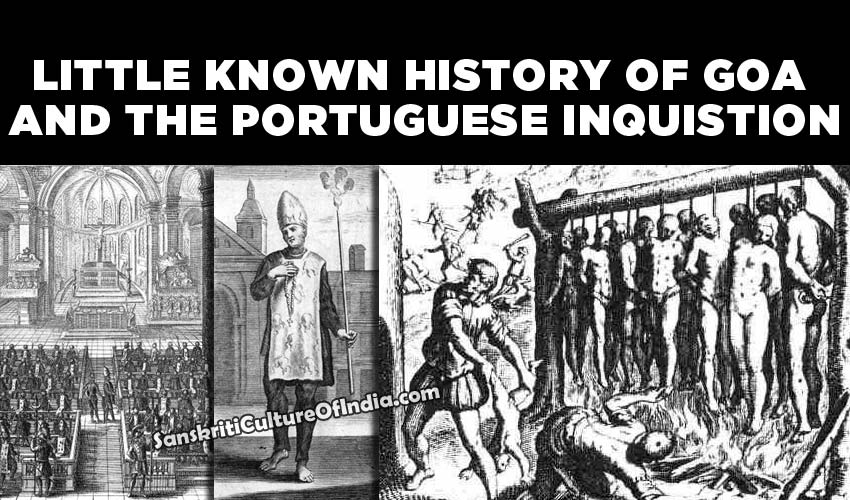The “‘Goa Inquisition”‘ was the office of the Inquisition acting in the Indian state of Goa and the rest of the Portuguese empire in Asia. Established in 1560, the inquisition was aimed primarily at Hindus with inquisitions against Indian Muslims, Indian Jews, and others.
By the time it was suppressed in 1774, the inquisition had had thousands of people were given the death penalty, tortured and executed.
The French philosopher Voltaire wrote about the Goa Inquisition where he observed:
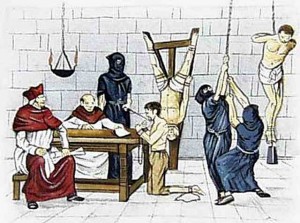 “Goa is sadly famous for its inquisition, which is contrary to humanity as much as to commerce. The Portuguese monks deluded us into believing that the Indian populace was worshipping the Devil, while it is they who served him” (Voltaire, Lettres sur l’origine des sciences et sur celle des peuples de l’Asie (first published Paris, 1777, letter of 15 December 1775)
“Goa is sadly famous for its inquisition, which is contrary to humanity as much as to commerce. The Portuguese monks deluded us into believing that the Indian populace was worshipping the Devil, while it is they who served him” (Voltaire, Lettres sur l’origine des sciences et sur celle des peuples de l’Asie (first published Paris, 1777, letter of 15 December 1775)
Sephardic Jews living in Goa, many of whom had fled the Iberian Peninsula to escape the excesses of the Spanish Inquisition to begin with, were also persecuted.
The records speak of the necessity for hundreds of prison cells to accommodate fresh victims. Seventy-one “autos da fe” were recorded. In the first few years alone, over 4000 people were arrested, with 121 people burnt alive at the stake.
The Hindus of Goa were one of the most affected by the inquisition. The condemned Hindus were publicly burned at the stake in the square outside the Sé Cathedral in batches during ceremonies . Those who confessed to their accused heresy would be strangled prior to the burning. In this case, heresy was to practice a faith other than Christianity.
Historian R.N. Sakshena writes “.. in the name of the religion of peace and love, the tribunal(s) practiced cruelties to the extent that every word of theirs was a sentence of death”.
Anti-Hindu laws and prohibitions
Laws were passed banning Christians from keeping Hindus in their employ, and the public worship of Hindus were deemed unlawful:
A large number of restrictive religious laws were enacted, including the banning of Hindu musical instruments and clothing. Hindu temples were converted or destroyed, and Christian churches built in their place, often from the materials of the temples they replaced. Throughout this period several important Hindu texts were burned in an effort to saturate the area with Christian religious texts.
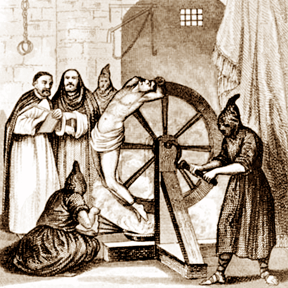 Orders were issued that Hindu children who were orphaned be “taken immediately and handed over to the College of St. Paul of the society of Jesus of the said city of Goa, for being baptized, educated and indoctrinated by the Fathers of the said College and being directed by them and placed in positions according to their respective aptitudes and abilities”. The order was endorsed by the viceroy of Goa, Antao de Noronha and the Governor, Antonio Moniz Barrette. While the original order applied only to orphans, there were frequent complaints that Hindu children with parents were kidnapped from their families and forcibly baptized. Some Hindu families secretly smuggled their children out of Goa. Other less fortunate Hindus paid extortion money to Christian priests to keep their children from being kidnapped and baptized
Orders were issued that Hindu children who were orphaned be “taken immediately and handed over to the College of St. Paul of the society of Jesus of the said city of Goa, for being baptized, educated and indoctrinated by the Fathers of the said College and being directed by them and placed in positions according to their respective aptitudes and abilities”. The order was endorsed by the viceroy of Goa, Antao de Noronha and the Governor, Antonio Moniz Barrette. While the original order applied only to orphans, there were frequent complaints that Hindu children with parents were kidnapped from their families and forcibly baptized. Some Hindu families secretly smuggled their children out of Goa. Other less fortunate Hindus paid extortion money to Christian priests to keep their children from being kidnapped and baptized
Many Christian priests disagreed with these draconian measures and sympathized with the Hindus, generating a brief lull in the forced conversions. However, Francis Xavier, the “Father of the Christians”, upon hearing of this, complained to the Archbishop and reinstated a new wave of forced conversions.
Several [anti-Hindu] laws were enacted with the expressed intent to “humiliate Hindus” and encourage conversions to Christianity. The viceroy ordered that Hindu pandits and physicians be disallowed from entering the capital city on horseback or palaquins, the violation of which entailed a fine. Successive violations resulted in imprisonment, Christian palaquin-bearers were forbidden from carrying Hindus as passengers. Christian agricultural laborers were forbidden to work in the lands owned by Hindus and Hindus forbidden to employ Christian laborers. The inquisition guaranteed “protection” to Hindus who converted to Christianity. Thus, they initiated a new wave of baptisms to Hindus who were intimidated by their brutality into converting.
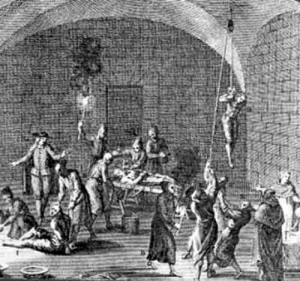 The inquisition supplied the ecclesiastic Jesuit priests with a strong state-sanctioned weapon to use against the Hindu population of the region. Moderate Catholics who tried to build bridges with Hindus were also persecuted. Even the governor of Goa from 1588-1591 was investigated when he consulted Hindu clerics about the auspicious dates concerning the arrival of ships. The adverse effects of the inquisition were tempered somewhat by the fact that Hindus were able to escape Portuguese hegemony by migrating to other parts of the subcontinent.
The inquisition supplied the ecclesiastic Jesuit priests with a strong state-sanctioned weapon to use against the Hindu population of the region. Moderate Catholics who tried to build bridges with Hindus were also persecuted. Even the governor of Goa from 1588-1591 was investigated when he consulted Hindu clerics about the auspicious dates concerning the arrival of ships. The adverse effects of the inquisition were tempered somewhat by the fact that Hindus were able to escape Portuguese hegemony by migrating to other parts of the subcontinent.
Hindus who were arrested for repeated violations of the laws were taken in by the inquisition to the “Palace of the Goa Inquisition” for “confessions”. The confessions were attained by various torture techniques. Techniques included Hindus being tied up and having their feet burned slowly with sulphur, water torture techniques and racks on which the victims were manacled and their joints slowly dislocated by stretching. This “strappado” method was a particular favorite among the inquisitors. Thumb-screws and leg-crushers called Spanish boots were also employed. Often, boiling oil was poured on their legs and sulphur dropped on their bodies with lighted candles held beneath their armpits. Another technique involved fixing the victims to revolving tables and whirling them round until they were nauseous. These techniques were applied to the victims until they were weakened to the point of being persuaded to “convert” to Christianity and “confess”.
Those who “confessed” were strangled to death and their corpses burned. Those who did not were burned alive at the stake. All the victims of the inquisition eventually had their shirts steeped in sulphur. Those who did not confess had their shirts painted with flames pointing upward. Those who did had their shirts painted with flamed pointing downward. They were taken from the palace to the Church during Sunday mass. Then, they were subjected to ridicule by the Christian parishioners. Once that ritual was complete, the non-confessors were strangled and their corpses, together with the living non-confessors, were “conducted to the Campo Sancto Lazaro” and burned at the stake in the presence of onlookers.
During the British Era, thousands of missionaries routinely defamed and denigrated Hinduism in books and pamphlets. they forcibly converted people to Christianity by kidnapping poor Hindus and forcing beef into their mouths, making them apostates by force and then torturing them to “confess” and convert. Then they would turn the converts against Hindus through propaganda and incite them into violence. It is these activities that led to the discontent among Hindus and Muslims in the great rebellion of 1857 and beyond.
In contemporary times, large parts of Northeastern India have become Christianized owing to the fervent activities of missionaries. In these states, especially Nagaland, Hindus are not able to celebrate Durga Puja and other essential festivals due to harassment and killing by Christian Terrorist groups. In Tripura, the “National Liberation Front of Tripura”, a designated terrorist organization, has targeted Swamis and temples for attacks. The Baptist Church of Tripura, instilled there by Christian white supremacists from New Zealand, has supplied NLFT with arms and financial support and encouraged the murder of Hindus, particularly infants. A conventional tactic of the terrorists is to torch houses of Hindus with the residents still in it. They have been known to raid Hindu sanctuaries and shoot all the members. They have killed a total of 13,000 Hindus over the course of the 1990’s before they split up and most of them surrendered to the Indian Army. Similarly, the Baptist Christians in Manipur in India have also committed anti-Semitism on the Bnei Menashe Jews of India, denying the Jewish Rabbis from Shavei Israel to teach them the Talmudic laws (with which they were unfamiliar since the Bnei Menashe left Israel before the Talmud was written and concluded by Rabbi Hillel).
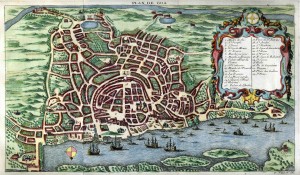 Similar atrocities were committed by Fundamentalist Christian terror groups such as the Nagaland Rebels, converted to Christianity in the same way as most others (i.e forcibly) and turned against Hindus.
Similar atrocities were committed by Fundamentalist Christian terror groups such as the Nagaland Rebels, converted to Christianity in the same way as most others (i.e forcibly) and turned against Hindus.
Hindus in Fiji constitute approximately 38% of the population. During the late 90’s there were several riots against Hindus by radical elements in Fiji. In the Spring of 2000, the democratically elected Fijian government led by Prime Minister Mahendra Chaudhry was held hostage by a guerilla group, headed by George Speight. They were demanding a segregated state exclusively for the native Fijians, thereby legally abolishing any rights the Hindu inhabitants have now. The Hindu minority are denied any land owning rights and are routinely attacked and harassed. Several dozen Hindu temples have been vandalized or destroyed by arson or looting.
The Methodist church of Fiji repeatedly calls for the creation of a Christian State and has endorsed forceful conversion of Hindus after a coup d’etat in 1987.
Indians, predominantly Hindus, came as indentured laborers in 1838 to British Guyana and later to Trinidad, Jamaica, Grenada, St. Lucia, Martinique, Guadeloupe and Surinam. During the initial decades of Indian indenture, Indian cultural forms met with either contempt or indifference by the Christian majority. Hindus have made many contributions to Trinidad history and culture even though the state historically regarded Hindus as second-class citizens. Hindus in Trinidad struggled over the granting of adult franchise, the Hindu marriage bill, the divorce bill, cremation ordinance, and others. After Trinidad’s independence from colonial rule, Hindus were marginalized by the African-based People’s National Movement. The opposing party, the People’s Democratic party, was portrayed as a “Hindu group”, and other anti-Hindu tactics were used against them. Hindus were castigated as a “recalcitrant and hostile minority”. Hindus were alienated by such Christian communal groups. The support of the PNM government to creole art forms in Carnivals, while their public rejection and ridicule of Hindu art forms, was a particular source of contention for the Hindu minority. The displacement of PNM from power in 1985 would improve the situation.
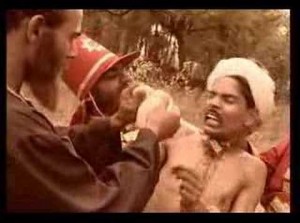 There has been persistent discontent among the Hindus with their marginalization. Many Christianized groups portray Hindus as “clannish, backward and miserly” (Just like Jews were characterized as such in Europe by Christians once). During the General Elections of 1986, the absence of the Bhagavad Gita and the Quran at polling stations for required oath-taking was interpreted as a gross insult to Hindus and Muslims. The absence of any Hindu religious texts at the official residence of the President of Trinidad and Tobago during the swearing in of the new Government in 1986 was perceived as another insult to the minority communities since they were represented in the government. The exclusivist Christian symbolism operative in the country’s top national award, the Trinity Cross, has persistently stung Hindu religious sensibility. This was to climax in 1995 with the refusal of the Hindu Dharmaacharya to accept the award, while issuing a statement that his action should be seen as an opportunity for those in authority to create a national award that recognizes the plurality of religious beliefs in this country. The national education system and curriculum have been repeatedly accused of such majority-oriented symbolism. The use of discernibly Christian-oriented prayers at Government schools, the non-representation of Hinduism in approved school textbooks, and the lack of emphasis on Hindu religious observace evoked deep resentment from the Hindu community. Intensified protests over the course of the 1980s led to an improvement in the state’s attitudes towards Hindus.The divergence of some of the fundamental aspects of local Hindu culture, the segregation of the Hindu community from Trinidad, and the disinclination to risk erasing the more fundamental aspects of what had been constructed as “Trinidad Hinduism” in which the identity of the group had been rooted, would often generate dissension when certain dimensions of Hindu culture came into contact with the State. While the incongruences continue to generate debate, and often conflict, it is now tempered with growing awareness and consideration on the part of the state to the Hindu minority. Hindus have been also been subjected to persistent proselytization by Christian missionaries.
There has been persistent discontent among the Hindus with their marginalization. Many Christianized groups portray Hindus as “clannish, backward and miserly” (Just like Jews were characterized as such in Europe by Christians once). During the General Elections of 1986, the absence of the Bhagavad Gita and the Quran at polling stations for required oath-taking was interpreted as a gross insult to Hindus and Muslims. The absence of any Hindu religious texts at the official residence of the President of Trinidad and Tobago during the swearing in of the new Government in 1986 was perceived as another insult to the minority communities since they were represented in the government. The exclusivist Christian symbolism operative in the country’s top national award, the Trinity Cross, has persistently stung Hindu religious sensibility. This was to climax in 1995 with the refusal of the Hindu Dharmaacharya to accept the award, while issuing a statement that his action should be seen as an opportunity for those in authority to create a national award that recognizes the plurality of religious beliefs in this country. The national education system and curriculum have been repeatedly accused of such majority-oriented symbolism. The use of discernibly Christian-oriented prayers at Government schools, the non-representation of Hinduism in approved school textbooks, and the lack of emphasis on Hindu religious observace evoked deep resentment from the Hindu community. Intensified protests over the course of the 1980s led to an improvement in the state’s attitudes towards Hindus.The divergence of some of the fundamental aspects of local Hindu culture, the segregation of the Hindu community from Trinidad, and the disinclination to risk erasing the more fundamental aspects of what had been constructed as “Trinidad Hinduism” in which the identity of the group had been rooted, would often generate dissension when certain dimensions of Hindu culture came into contact with the State. While the incongruences continue to generate debate, and often conflict, it is now tempered with growing awareness and consideration on the part of the state to the Hindu minority. Hindus have been also been subjected to persistent proselytization by Christian missionaries.
Christian missionaries operate a network of hate sites and hate groups all over the world that spread misinformation and falsehoods against Hindus and incite others to attack and murder them.
Historian Alfredo de Mello aptly describes the performers of Goan inquisition as, nefarious, fiendish, lustful, corrupt religious orders which pounced on Goa for the purpose of destroying paganism (ie Hinduism) and introducing the true religion of Christ.

